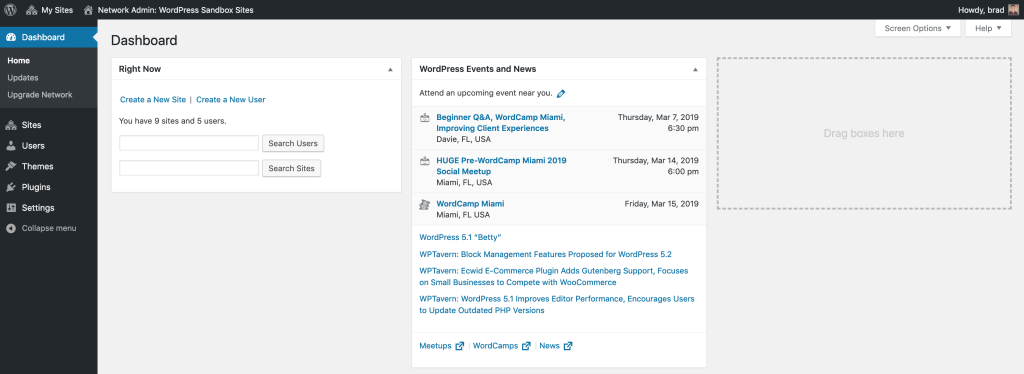If you’re a freelance developer or agency that builds a lot of WordPress sites, you may have wondered whether hosting client sites with WordPress MultisiteMultisite is a feature of WordPress that allows a user to create and manage multiple websites from a single Wo... More is a good idea.
For some, hosting client sites with Multisite can be a huge time-saver and make your workflow far more efficient. For others, the various drawbacks can outweigh the benefits.
To help you make an informed choice for your business, let’s take a close look at the pros and cons of hosting client sites on a WordPress Multisite network.
What Is WordPress Multisite?

Introduced with WordPress 3.0 in 2010, WordPress Multisite allows you to create a network of sites that share a single WordPress installation, using a common databaseA database is an organized collection of data stored and accessed electronically. It is a crucial component of... More and a shared set of themesA WordPress theme is a set of files that determine the design and layout of a website. It controls everything ... More, plugins, and users.
This means you can manage an unlimited number of individual websites from a single WordPress dashboardIn WordPress, the Dashboard is a central hub for managing a website's content and settings. It is the first sc... More, saving time by pushing core, pluginA plugin is a software component that adds specific features and functionality to your WordPress website. Esse... More, and theme updates to all of them at once. Think of it as your very own instance of WordPress.com.
WordPress Multisite is not a plugin—it’s a core feature that can be enabled on any standard WordPress installation.
Using Multisite For Client Sites: The Pros

Let’s first take a look at some of the benefits of hosting client sites with WordPress Multisite.
Easy Site Management
One of the key benefits of using a Multisite network is the ability to manage all of your sites from a single dashboard, and with a single account.
When you create a network, your account will take on the user role of Super Admin, and you’ll gain access to a new Network Admin dashboard where you can manage all of your sites from one central location.
More Efficient Workflow For New Sites
Because network sites share a single WordPress installation, you only have to install themes and plugins once.
This is a huge timesaver if you tend to use the same few themes (or a custom framework) for all of your sites. It’s also helpful to have your essential plugins pre-installed on day one.
If you find yourself creating the same types of sites over and over—e.g. a brochure-style site for a local business—you can create a boilerplate site with the most common pagesIn WordPress, a page is a content type that is used to create non-dynamic pages on a website. Pages are typica... More and configurations, then use Multisite Clone Duplicator to clone it each time you begin a new site.
Network-Wide Updates
When it comes to WordPress security, few things are more important than keeping your site updated.
When you’re managing dozens or hundreds of individual client sites, installing updates can be an intensive, time-consuming process. Automatic updates can help, but they still require some supervision to ensure nothing breaks.
With a Multisite network, you can push core, theme, and plugin updates to an entire network instantly.
Of course, it’s a good idea to test new updates in a staging environment before pushing them to an entire network—but that still beats logging in and updating all of those sites individually.
Simpler Backups
It’s important to back up your data, but maintaining regular backup solutions on a large number of sites can be messy and expensive.
When you use a WordPress Multisite network, you only have one WordPress installation (and one database) to back up.
With that in mind, make sure you use a Multisite-compatible backup plugin—because some solutions don’t support network backups.
Granting Access To Multiple Sites
Creating a WordPress account for a client is relatively straightforward, but it can get messy when you manage multiple sites for that client and they need dashboard access to all of them.
With a WordPress Multisite network, you can create a single account for the client and simply assign that account to each of their sites.
Network-Wide Branding
If you like to brand your admin area for your clients, Multisite goes a long way to facilitate that.
Using a Multisite-compatible plugin like Branda, you can customize your WordPress dashboard once for all of your clients, and you can make network-wide changes at any time.
Streamlined Support
Ordinarily, client support can be pretty disorganized.
Having all of your users in one place gives you the opportunity to create a single, streamlined ticket system where you can handle support inquiries from all of your clients.
Using Multisite For Client Sites: The Cons

Despite the many benefits, Multisite also has some drawbacks that you should consider before building out a network of client sites.
Not Ideal For Clients Who Need Hosting Account Access
If your clients need direct access to a hosting account, Multisite likely won’t be a viable option.
Because a Multisite network shares a single database and WordPress installation, you won’t be able to provide clients with their own cPanel, FTP, or SSH accounts.
In such a case, you’d be much better off with a reseller hosting package.
Your Clients Can’t Install Their Own Themes Or Plugins
Along the same lines, if your clients need to be able to manage their own themes and plugins, Multisite may not be for you.
Even with admin access at the site level, your clients will need you (or another Super Admin) to install and enable themes and plugins before they can use them.
You Can’t Isolate Client Sites
If your clients have WordPress accounts on your Multisite network, they’ll technically be logged in to all of your sites, including those of other clients.
By default, every new user has “subscriber” access to all sites on the network. This doesn’t allow them to edit anything, but if you’d rather not have your users mingling, you may want to stick with separate WordPress installations.
Highly Unique Sites May Defeat The Purpose
If all of your projects are totally unique—that is, using different themes, plugins, and configurations—you may miss out on the key benefits of Multisite.
The result could be a bloated, disorganized network that doesn’t actually improve your workflow.
Shared Resources
By its very nature, a Multisite network shares resources across all of its sites. This means that if one of your client sites goes down, they all go down.
One high-traffic or poorly optimized site can impact the performance of all of your other sites.
This can be mitigated by investing in high-quality infrastructure, but the risk of shared resources is something to keep in mind.
Shared Security Risk
Sharing a single database can also be a security vulnerability.
Malware and other security threats won’t be confined to a single site. In other words, if one of your sites gets hacked, they all get hacked.
The Bottom Line
Given all the factors above, should you use WordPress Multisite for your client sites?
Here are some quick guidelines to consider:
You may want to use WordPress Multisite for your clients if:
You probably don’t want to use Multisite for your clients if:
What do you think? Do you use WordPress Multisite for your clients? Are you considering it? We’d love to hear your thoughts and experiences in the commentsComments are a feature of WordPress that allow users to engage in discussions about the content of a website. ... More below!



